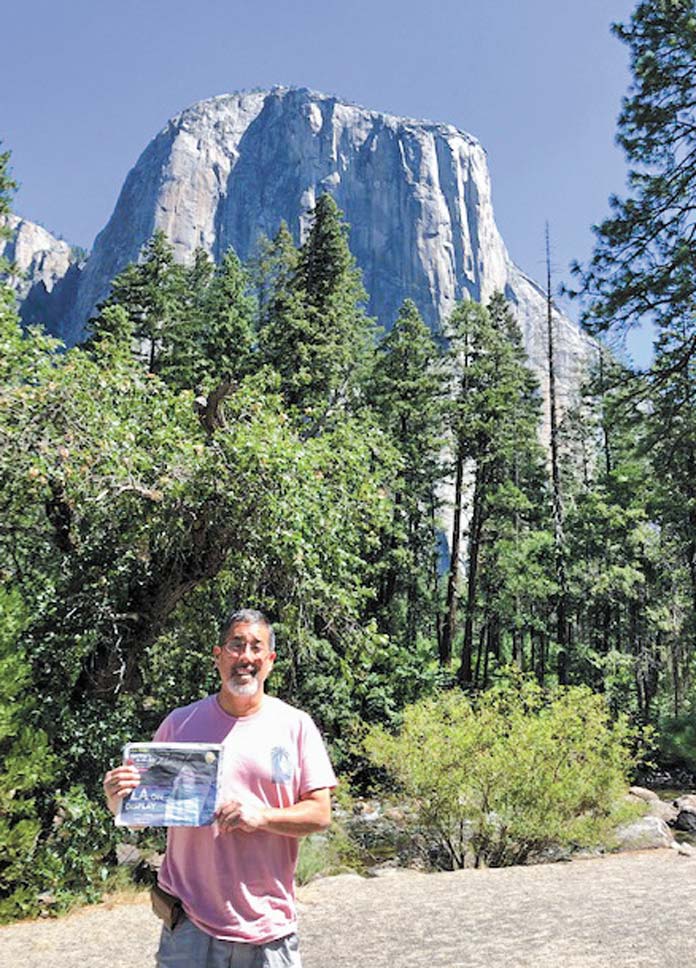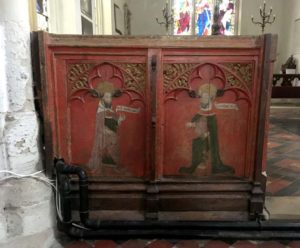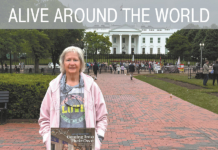 Send in your ALIVE! AROUND THE WORLD
Send in your ALIVE! AROUND THE WORLD
Take Alive! with you wherever you go! Bring your recent copy of Alive! with you when you travel and snap a high resolution photo of you holding Alive! Send in your pictures and text (click on the button to go to the form), and we’ll publish it.
SUBMIT YOUR ALIVE! AROUND THE WORLD
![]()
Yosemite
“Our family took a trip to Yosemite in August 2021 (first time for the boys) and went to the usual tourist spots in Yosemite Village. However, there was a freak hailstorm just outside the village the next day after a beautiful sunny day previously, which just goes to show to be prepared for all sorts of weather! Either way, it;s a beautiful spot to visit.”
— John Otoshi, Retired, LADWP


Letter From England, Pt. 1
Capt. Michael Barnes, Retired, Harbor, traveled to the land of his birth, England, post-vaccination.
England, That Fair and Pleasant Land
 With the lifting of the COVID-19 travel restrictions, we decided it was time to take a long overdue trip to our little corner of that fair and pleasant land across the pond.
With the lifting of the COVID-19 travel restrictions, we decided it was time to take a long overdue trip to our little corner of that fair and pleasant land across the pond.
Deep in the rolling chalk hills of Hertfordshire in the country Village of Kelshall is my cousin’s farm about two miles from the ancient track way called the Icknield Way that runs from Norfolk to Wiltshire. It was here we based ourselves for a couple of adventurous weeks to explore the surrounding English countryside, village by village.
His space is primarily an arable farm, raising a variety of corn and hay. There is a small stable for local horses, with a large paddock for them in which to exercise. The farmhouse is quite large, with flagstone floors and a kitchen with space to feed 18 beaters breakfast. The dining room can entertain eight to 12 guns during the shooting season.
 Over the centuries, England has been invaded many times, starting in 55 B.C. by Julius Caesar’s Romans who not only brought peace and culture but a new local highway called Ermine Street that ran from London to Lincoln, which certainly helped in getting around. But with the collapse of the Roman Empire in 450, that all ended.
Over the centuries, England has been invaded many times, starting in 55 B.C. by Julius Caesar’s Romans who not only brought peace and culture but a new local highway called Ermine Street that ran from London to Lincoln, which certainly helped in getting around. But with the collapse of the Roman Empire in 450, that all ended.
Next to appear were the Angles (Germans) from northern Europe, but after 390 years of fighting they could only establish small tribal kingdoms. With so much petty squabbling they were easy prey to the Vikings, England’s next invaders. After another 300 years of rape and pillaging, finally the Angles settled down, only to be oppressed by the invading Normans (French) in 1066.
Because the Village of Kelshall sits on a high chalk hill it was the perfect place for the Normans to build a church and signal tower. With a commanding view, it also just so happens to be next to the farmhouse garden and bottom paddocks. There is even a private door in the red-brick-walled churchyard for easy access to services at St. Faith’s church.
The church’s front entrance is at the end of a shady lane surrounded by ancient beech, elm and pine trees, next to the Old Rectory, and surrounded by flint stone walls. Unfortunately, of the earlier church of St. Faith’s, nothing is left but the broken preaching cross standing in the churchyard.
 Today’s church was built between 1388 and 1425 by John Fordham — local farmer, landowner and Bishop of Ely. Four hundred years later in Victorian times the church’s external flint and bath stone walls, along with the slate chancel roof, were restored, but the bell tower with its five bells and embattled parapet was not repaired until 1911.
Today’s church was built between 1388 and 1425 by John Fordham — local farmer, landowner and Bishop of Ely. Four hundred years later in Victorian times the church’s external flint and bath stone walls, along with the slate chancel roof, were restored, but the bell tower with its five bells and embattled parapet was not repaired until 1911.
Entrance is through the south porch’s new glass entrance doorway, protecting the original large solid oak entrance door with its medieval latch mechanism. Except for a few small repairs, the mechanism has stood the test of time well. Upon entering the church, the entrance to the bell tower is on the left, and just beyond that are the five ropes for tolling the bells and the new screen with the painted images of the King, Bishop and St. Faith. Looking down the main nave to the altar you will see the graceful 15th-century pillars and arches on either side supporting the roof, which was re-painted in Victorian times with a vine and leaf design similar to many East Anglian churches of that time, with supporting angel corbels.
The floor of the main aisle is paved with various local family memorial head stones, leading up to the circa-1425 small brass plaque in Purbeck marble for farmers Richard and Maryon Adame in front of the chancel step. This is one of the earliest plaques written in English and not Latin, and they died hoping their inscription would be completed for them.
The glass of the east window in the chancel was replaced in 1875 and depicts Faith, Hope and Charity. There are still a few fragments of the original 15th-century glass in one of the Tudor arched windows in the north wall.
On the wall of the church are memorials to all the local men who died in WWI, and also a very interesting list of all the rectors who had served in the church since 1277. Note the number of father/sons who had served the church, including Cromwellian puritans in 1600.
 Once again outside on the small green in the middle of the village is a worn stone base of a village cross that probably belongs to the 14th century. There is also an obelisk constructed to celebrate the second millennium and containing a time capsule in its base. Nearby is the old village school building, now the Village Hall with an old red public telephone box that has been turned into a mini free library-book exchange.
Once again outside on the small green in the middle of the village is a worn stone base of a village cross that probably belongs to the 14th century. There is also an obelisk constructed to celebrate the second millennium and containing a time capsule in its base. Nearby is the old village school building, now the Village Hall with an old red public telephone box that has been turned into a mini free library-book exchange.
This village is virtually unspoiled and truly the old England of my youth. This is not a popular tourist site, so you will be able to appreciate the peace and quiet of the lovely place.




















